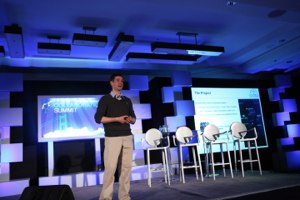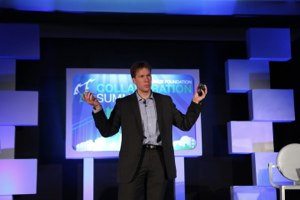The Linux Foundation’s executive director Jim Zemlin sees a new trend in the technology industry toward a collaborative development model. Companies are focusing their research and development efforts outward and participating more in open source projects to accelerate innovation and progress, he said in his opening remarks at The Linux Foundation’s Collaboration Summit in San Francisco.
It’s no coincidence, then, that the conference kicked off this morning with a warm welcome to the Xen Project, the foundation’s newest collaborative project, which is also celebrating its 10-year anniversary today as a virtualization platform. The announcement comes on the heels of last week’s OpenDaylight software-defined networking project launch.
 “What we see now is that most technology is being defined by this collaborative development,” Zemlin said.
“What we see now is that most technology is being defined by this collaborative development,” Zemlin said.
Jaguar Land Rover
The Automotive Grade Linux work group is a prime example of how this new collaborative model is taking over an industry that hasn’t traditionally been open to third-party developers. AGL today released the IVI & remote vehicle interaction demonstration, a downloadable open source image for creating an in-vehicle-infotainment system complete with the CAN stack and an HTML5 application framework and sample user interface.
The goal is to create an open source IVI platform that meets customer expectations to have the experience from their consumer electronics devices in their vehicles such as voice control, constant connectivity and media management, said Matt Jones, a Senior Technical Specialist for infotainment systems at Jaguar Land Rover and the Vice President of the non-profit GENIVI Alliance, an automotive industry effort to drive adoption of an IVI open-source development platform.
“We’re heavily involved with AGL to enable open source and Linux within automotive as a whole and focus on making it easier for developers with reference hardware and software platforms,” Jones said. Such technology “has been available in lots of vehicles but nobody has given it away before.”
The group is now looking for collaborators to help integrate navigation into the UI, as well as BlueZ for telephony and has announced a developer contest. Developers can compete for the chance to work with the AGL and Jaguar Land Rover by entering work in three categories: best user experience, best visual appearance, and best new concept or additional feature. The contest runs April 15 – May 17 and winners will be announced at the Automotive Linux Summit in Tokyo at the end of May.
 “I want what we create to be available on every vehicle,” Jones said. “It should be easy to translate that software across platforms. We just need to get the features out there.”
“I want what we create to be available on every vehicle,” Jones said. “It should be easy to translate that software across platforms. We just need to get the features out there.”
Samsung
While the automotive industry is just starting to dive into open source, Samsung Electronics has established itself as a significant contributor to the Linux kernel and the open source community. The consumer electronics giant began using open source about 10 years ago, starting with embedded Linux in some prototype devices, said Sang-bum Suh, Vice President of the software platform team in the Software R&D Center at Samsung. That soon expanded to flat panel TVs when the company switched from a RTOS to Linux. And its use of Linux now extends to smartphones, camcorders and cameras.
Last year Samsung’s Galaxy Android smartphone sold more than 200 million units and 57 million digital TV units, “all based upon linux and comprised of open source components,” Suh said.
“I believe that open source components have contributed to Samsung’s business success very much.” he said. So much so that Samsung has expanded its contributions to Linux and open source, becoming one of the top 10 contributors to the Linux kernel in 2012. It now employs more than 20,000 software developers whose work is based in large part on open source components, Suh said. And they’re hiring.
“We believe we have been successful in the past on hardware components,” Suh said. “In the future we’d like to add software  capabilities to that hardware success.”
capabilities to that hardware success.”
Adapteva
The final morning keynote brought rounds of applause from attendees as Adapteva CEO Andreas Olofsson unveiled two Parallella boards – the first off the assembly line since the company’s Kickstarter campaign six months ago. (For more background on the Parallela and Adapteva’s vision, see our Q&A and a recap of our live chat with Andreas.) Holding one board in each hand, Olofsson discussed the immense challenges Adapteva and the rest of the computer industry faces in finding ways to improve performance and minimize energy consumption.
Adapteva is “possibly the world’s smalled semiconductor company,” he said, trying to solve some of the biggest problems in computing.
Chip design trends will shape the future of computing, addressing power conumption, a memory bottleneck, wiring, thermal density, yield issues and more. Parallel computing is the answer, he said.
“Today we’re at a high level of abstraction but parallel programming isn’t there yet,” Olofsson said. “The challenge is how to make parallel programming as productive as Java or Python is today… running on any type of hardware.” A beginning programmer should be able to do parallel programming as easily as someone with 20 years of experience, he said.
The Parallella, a dual-core processor that runs on Linux, is Adapteva’s attempt to create a market for parallel programming by making it cheap and easy.
“One of the key things in launching this project was (realizing) the only way to make it work is to make it completely open… which can be incredibly scary to a hardware engineer,” Olofsson said.
The past six months the three-developer company didn’t know if it could really deliver on the project, he said. Now they see it working. After more testing and production, they’ll ship 6,300 boards to their kickstarter backers and will give away 100 free kits to universities.
“The good news is we have boards working,” Olofsson said. “We’re running a little bit late but we’re going to ship them this summer.”
The Linux Foundation’s Collaboration Summit is taking place this week in San Francisco, from April 15-17. Catch the rest of our day-one keynotes for free via our live video stream on the Events website. And check back into Linux.com later today and tomorrow for more coverage and photo slideshows of this week’s event.


